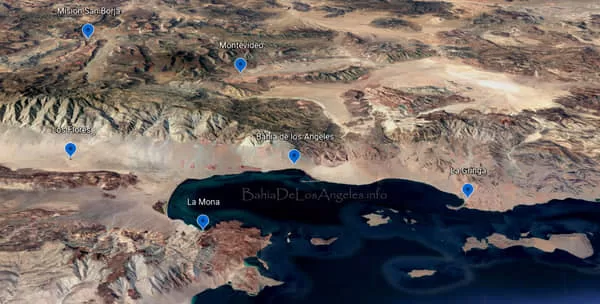Archaeology of the Bahía de los Ángeles Biosphere Reserve

Archaeological surveys and limited excavations within Bahía de los Ángeles and Bahía
las Ánimas indicate that indigenous peoples may have occupied the region subsumed by the
Bahía de los Ángeles Biosphere Reserve for 6,000 years or more. Sites include coastal shell
mounds, camp clearings and piled rock enclosures, stone tool manufacturing sites, burial sites,
trails, and rock art sites. Artifacts include projectile points, simple cutting and scraping tools,
flaked shell tools, milling stones, and post-Spanish ceramics. Projectile points and milling stones
provide evidence of hunting and gathering of terrestrial mammals and plant foods. Shell mounds
attest to heavy exploitation of littoral and marine resources, especially shellfish, sea mammals,
sea turtles, fish, and crabs. Although local chronology is sketchy, reliance on seafood appears to
have increased during late prehistoric times. These late peoples are known archaeologically as
the Comondú culture and historically as the Cochimí Indians. Although Isla Ángel de la Guarda
is less well known archaeologically, it too was extensively utilized by indigenous peoples. Most
sites and artifacts are similar to those of the adjoining peninsula, suggesting that the people who
occupied the peninsula made frequent voyages to the island over centuries or millennia.
Archaeological sites on both the peninsula and island are increasingly threatened by
development, recreationalists, and looting, but no conservation strategy has yet been developed
or implemented.
https://www.sandiegoarchaeology.org/Laylander/Baja/05bowen.pdf
Investigations of Prehistoric Behavioral Ecology and
Culture Change within the Bahía de los Angeles Region,
Baja California
Abstract
Archaeological investigations by the University of California during the 1990s in the greater
Bahía de los Angeles region of Baja California included sample inventory and limited test
excavations. This research resulted in the documentation of 74 sites and a better understanding
of the 6000 plus years of changing regional occupation and use. It is proposed that relatively
mobile, thinly scattered populations began to increase around 1000 – 1500 years ago. More
interior-coastal interaction is suggested to have occurred during at least late prehistory con-
comitant with more efficient food acquisition practices and, perhaps, improved water manage-
ment. Cultural events in nearby and more distant regions and possible climatic perturbations
may have exerted some influence on local settlement/subsistence patterns. The conceivable
marginal increases in overall cultural complexity during late prehistory were interrupted by the
Spanish entrada.
Bahía de los Ángeles : recursos naturales y comunidad : línea base 2007
Includes bibliographical references
Geología / Luis A. Delgado-Argote — Oceanografía / Saúl Alvarez-Borrego — Clima / Tereza Cavazos — Paisajes culturales / Patricia Aceves-Calderón y Hugo Riemann — Arqueología / Thomas Bowen, Eric W. Ritter y Julia Bendímez-Patterson — Reseña histórica / Carolina Shepard-Espinoza y Gustavo D. Danemann — Macroalgas / I. Pacheco-Ruíz [and others] — Vegetación terrestre / Hem Nalini Morzaria-Luna y Sergio A. Barocio-León — Humedales / Hem Nalini Morzaria-Luna y Gustavo D. Danemann — Corales pétreos / Héctor Reyes-Bonilla [and others] — Opistobranquios / Hans Bertsch — Equinodermos / María Dinorah Herrero-Pérezrul — Tiburón ballena / Natalie Rodríguez-Dowdell, Roberto Enríquez-Andrade y Nirari Cárdenas-Torres — Peces arrecifales / Carlos Viesca-Lobatón [and others] — Recursos pesqueros / Victor M. Valdez-Ornelas [and others] — Tortugas marinas / Jeffrey A. Seminoff [and others] — Herpetofauna terrestre / Robert Lovich y Clark R. Mahrdt — Aves acuáticas / Daniel W. Anderson y Eduardo Palacios — Ballenas y delfines / Gisela Heckel, Paloma Ladrón de Guevara y Lorenzo Rojas-Bracho — Pesca ribareña / Gustavo D. Danemann, Esteban Torreblanca-Ramírez y Fermín Smith – Guerra — Pesca deportiva / Esteban Torreblanca [and others] — Servicios turísticos / Benjamín Casillas-López y Gustavo D. Danemann — Tenencia de la tierra y conservación de tierras privadas / Miguel Á. Vargas, Fernando Ochoa y Gustavo D. Danemann — Conservación ecológica / Gustavo D. Danemann, Exequiel Ezcurra y Enriqueta Velarde
https://archive.org/details/bub_gb_kSP02XgNpbIC/mode/2up
Investigations of Prehistoric Behavioral Ecology and Culture Change within the Bahía de los Angeles Region, Baja California
Archaeological investigations by the University of California during the 1990s in the greater Bahía de los Angeles region of Baja California included sample inventory and limited test excavations. This research resulted in the documentation of 74 sites and a better understanding of the 6000 plus years of changing regional occupation and use. It is proposed that relatively mobile, thinly scattered populations began to increase around 1000 – 1500 years ago. More interior-coastal interaction is suggested to have occurred during at least late prehistory con- comitant with more efficient food acquisition practices and, perhaps, improved water manage- ment. Cultural events in nearby and more distant regions and possible climatic perturbations may have exerted some influence on local settlement/subsistence patterns. The conceivable marginal increases in overall cultural complexity during late prehistory were interrupted by the Spanish entrada.
Natural Protected Areas in Baja California
In Baja California we can find terrestrial and marine natural areas with high biological richness and environmental value, these areas have different protection categories. Currently there are over 500 natural protected areas in Mexico that represent over 90 million hectares. This is part of the efforts of the federal government through the Commission of Natural Protected Areas, also known as Conanp.
A community immersed in natural and cultural heritage, generations that have adapted to their environment and have managed to coexist with species and protected natural areas. Special edition of one of the chapters of the series Monumental Landscapes, intangible value of natural and cultural wealth.

Keine Kommentare